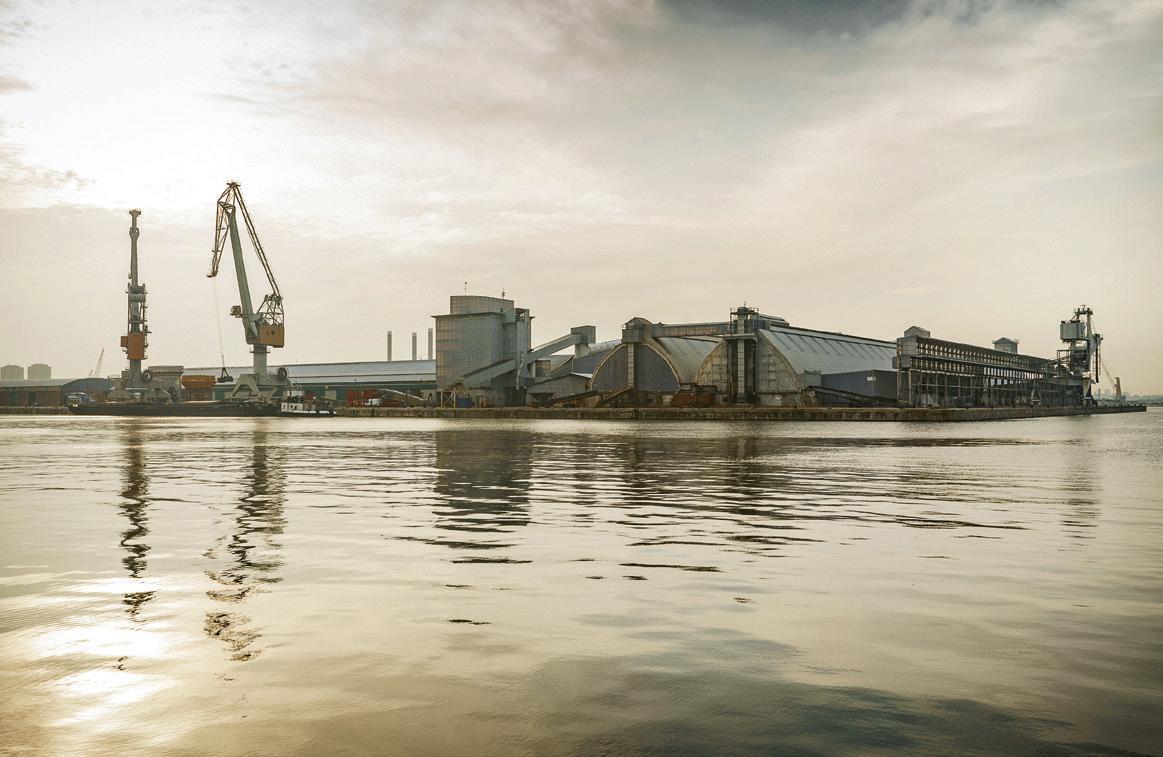
5 minute read
QUALITY GREEN COFFEE S BELGIAN PORTOF CALL
EN ROUTE TO EXCELLENCE ANTWERP: COFFEE PORT OF CALL







AS IT TRAVELS FROM TREE TO CUP,NESPRESSO GRAND CRU COFFEE UNDERGOES A VAST NUMBER OF QUALITY CONTROLS TO GUARANTEE PERFECTION.WHEN STOPPING IN THE PORT OF ANTWERP,THE GREEN COFFEE FROM AROUND THE WORLD IS SUBJECT TO A BATTERY OF TESTS BEFORE SETTING OFF AGAIN FOR SWITZERLAND.


ANTWERP




MOLENBERGNATIE.QUAY 5.10:00 A.M.The containers are carefully arranged in numbered rows. The names of the countries of origin – Brazil,Colombia,Ethiopia,India – are clues to the nature of the long-haul cargo. This scene has unfolded in exactly the same way since the 16th century,when the Belgian port of Antwerp was the link between the Indies and the New World, channelling the flow of raw co ee. Today, Nespresso’s sup-
85% of Nespresso coffee passes through the port of Antwerp in Belgium.
plies travel this same maritime route. Once in Antwerp, it may go to one of two places: Molenbergnatie or Seabridge, warehouses dedicated to Nespresso’s green co ee. The brand carries out identical quality-control protocols at these sites to ensure the excellence of its beans from around the world.
While on this Antwerpian stopover,between the just-arrived shipping container and the truck taking the green coffee to its Swiss roasting destination,nothing is left to chance. Unloading, sampling, warehousing, preservation: a strict traceability system is honoured by professionals committed to coffee quality. All to preserve that which gives Nespresso Grands Crus its exceptional character: the physical perfection and sensory richness of the green coffee.
PAMPERED BEANS
This morning, with the chill of autumn in the air, the warehouse sta begins the day with a meticulous inspection of the container. Should any anomaly be detected, the vessel will be isolated; later, if need be, it could be
Raw coffee samples are collected for quality control.
definitively removed.When the metal container is opened, jute sacks of green co ee, weighing 60 to 70 kilograms each,slide down to the conveyor belt.An initial inspection verifies their weight and moisture level and removes any units showing the slightest defect.Then comes the key sampling phase: a small amount of co ee is taken from each sack,then stored in a paper bag,providing a summary of the cargo. Once labelled, this sample is divided into two parts: one will go to the Nespresso physical and sensory analysis o ces in Switzerland, which will accept or reject each load. The other part is archived for three months as a reference sample, to be used by green co ee buyers working hand-in-hand with Nespresso.

The sacks, stacked on pallets, now travel to the storage warehouse, a veritable maze devoted entirely to Nespresso. In one of the secure,5,000m2 buildings,the neatly arranged sacks form colossal columns. Warehouse signage identifies the origins. Printed on the hessian, an ICO (International Co ee Organization) number ensures the co ee content’s traceability,connecting it to a country,an
AN INITIAL INSPECTION SORTS OUT ANY BEANS SHOWING THE SLIGHTEST DEFECT.
exporter and,at the end of the supply chain,a grower.The green co ee stored in these warehouses is as cosseted as a newborn.The city of Antwerp,o ering a relatively stable climate year‘round,boasts perfect conditions for preserving the beans’ freshness and flavour. Nevertheless,humidity and temperature deviations in the Molenbergnatie warehouse are measured daily and the structure’s architecture was designed specifically to mitigate the vagaries of the weather.At Seabridge,temperature and humidity are constantly monitored.
TASTER CHOREOGRAPHY
Downtown Antwerp, 11:30 a.m. The green co ee experts from Efico now take centre stage, as Nespresso's partner •••


Archiving the bags serving as reference samples. The tasters inspect the green coffee’s sensory characteristics.

The green coffee brew is tasted using a traditional silver spoon.
Headed to Switzerland Once the inspections are completed in Antwerp, Nespresso must still approve the taste tests in Switzerland. The green coffee is then stored in the Molenbergnatie and Seabridge warehouses or transported by train to the Nespresso production centre.

company that buys green co ee for the Swiss firm. The specialists, each in a pristine apron,pass back and forth between the room reserved for archiving, where all the samples are kept, and the “cupping” room that is the tasting area.In the hushed atmosphere of this historic building, spicy aromas blend with the roasted notes of the beans. Each sample taken at Molenbergnatie or Seabridge is roasted and ground in a very specific way,then brewed for a curious ritual that is repeated twice each day. The tasters “siphon” the fluid – a string of rhythmic sucking and breathing actions and mouth movements forming a well-rehearsed choreography. By the time they spit out the brew, they have carefully assessed its characteristics and nuances, which they record in careful detail.“Each sample must match the profile Nespresso is looking for, both in origin and variety,” says Bart Van Sanden, Belgium’s 2015 Cuptasting Champion and the world’s 2009 runner-up in the discipline.“Our teams perform exactly the same inspection before the beans are shipped out of the country of origin. Here, we’re making
sure that the‘gourmet’quality that Nespresso initially sourced hasn’t varied in the slightest. This is part of the traceability system that Nespresso enforces on an industrial scale, but that is as precise as that of an artisanal co eemaker,” says Michel Germanès, Efico’s Managing Director. Once the bean quality has been given the blessing of Nespresso in Switzerland, the sacks are stored in the warehouses or head for the brand’s production centres by rail, to minimise the co ee’s carbon footprint. Upon arrival, it undergoes yet another series of controls before moving on through the delicate steps of production: roasting, blending, grinding, encapsulation. The co ee’s journey from tree to cup is nearing its destination… n










